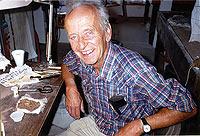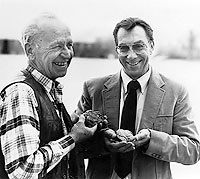Imagine being born in Germany in 1921 and drafted into Hitler’s army as a reluctant 18-year-old. Also imagine then taking more than a year to walk and fight one’s way from Romania across Ukraine to Stalingrad, one of the most notorious cities caught up in World War II. This was just the beginning of an odyssey of survival for one Karl Franz Hirsh who survived two war wounds, one very serious, and three years in Soviet Prison camp, before he emigrated to the USA to start a new life and become famous in the world of Paleontology.
 |
| Karl Hirsch, became a famous Dinosaur Egg expert. He survived horrendous war experiences in Germany and the Soviet Union to start a new life in the USA as a leading light paleontology during the “Dinosaur Renaissance.” |
Happily for myself and those who know Karl, he loved skiing and the outdoor life, and soon after his arrival in Colorado, in the 1960s, he and his wife made regular fossil hunting trips with rock hound clubs all over the region. The Moab area was one of their favorite destinations. His story is well known to paleontologists in Colorado and Utah and revolved around the chance discovery of a fossil egg in the badlands of Nebraska. Karl recalled he “looked down and there was a perfect egg.” The study of eggs, known as “oology” had traditionally been about collecting attractive eggs of rare birds, a practice much frowned on today, if not downright illegal in most places. At the time of Karl’s find, little was known about fossil eggs, or how to interpret them. Unless one can find a near-full-term embryo inside the egg, it is impossible to known which species laid it. Fortunately, in the 1970s, the Dinosaur Renaissance was underway and dinosaur eggs and nests were getting a new recognition thanks to Montana native, Jack Horner and discoveries which made Bozeman’s Museum of the Rockies famous. Horner would help show that dinosaurs nested in colonies and, based on a species that cared for its young before they left the nest, he named Maiasaura (the “good mother”) duck billed dinosaur.
 |
| Karl Hirsch (left) and one of his paleontological colleagues (Wade Miller, BYU) described the first Jurassic Dinosaur Egg from the Cleveland Lloyd Quarry. It was probably laid ny Allosaurus, the Utha state fossil. |
Among his many scientific and “oological” accomplishments Karl was able to help classify different types of dinosaur, bird, crocodile and turtle eggshell, and show the difference between hard and soft shell eggs. While the Montana dinosaur nesting sites date from the late Cretaceous (~75 million years), it was sometime before Jurassic dinosaur eggs were found. Karl hit the paleontological jackpot when he described a single egg from Utah’s Cleveland Lloyd Dinosaur Quarry, famous as a ~150 million-year-old Allosaurus graveyard. Publishing in the prestigious journal Science, Karl and his Utah paleontologist colleagues inferred that the egg had probably never been a laid. Its dinosaurian creator, probably an Allosaurus, had died while the egg was still pliable in its mother’s oviduct. It was one egg found among some 10,000 bones, a classic example of how some fossil evidence is rare and difficult to find and interpret.
For a man who had walked thousands of miles across the Soviet steppe and survived a starvation diet in prison camp, the occasional rigors of heat, cold wind and discomfort in the field were nothing, one might say pleasant walks in Jurassic and Cretaceous Parks. Having been denied a formal education by Germany’s infamous dictator, Karl became the acknowledged, self-taught, world leader in the field of fossil eggs (oology). I called him the “Dinosaur Egg Man” or “eggspert”! Among various awards, he earned an honorary PhD from the University of Colorado and bequeathed the museum many thousands of eggshells, microscope slides and high magnification electron microscope photographs, which he had prepared over two decades of intensive study. Karl made the technical study of dinosaur eggshell structure into a mature and interesting science. As a tribute to his legacy, Kenneth Carpenter, who recently retired as director of the Prehistoric Museum in Price, dedicated his book Dinosaur Eggs, Nest and Babies to Karl. He was much loved and admired by colleagues and those he mentored and brought into this new field of Paleo-oology.
For more information, go to: https://ucmp.berkeley.edu/science/eggshell/eggshell_hirsch.php |